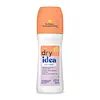Dry Idea Strong Natured Plant-Based Invisible Solid Antiperspirant & Deodorant Versus Dry Idea Deodorant & Antiperspirant Roll-On
What's inside
What's inside
 Key Ingredients
Key Ingredients

 Benefits
Benefits

No benefits
 Concerns
Concerns

 Ingredients Side-by-side
Ingredients Side-by-side

Aluminum Zirconium Trichlorohydrex Gly 18%
AstringentStearyl Alcohol
EmollientSclerocarya Birrea Seed Oil
HumectantShea Butter Ethyl Esters
EmollientEthylhexyl Olivate
Skin ConditioningTetradecane
PerfumingOryza Sativa Bran Wax
Skin ConditioningTrihydroxystearin
Skin ConditioningButyrospermum Parkii Butter
Skin ConditioningSilica
AbrasivePolyglyceryl-10 Caprylate/Caprate
EmulsifyingParfum
MaskingHydrogenated Castor Oil
EmollientCetyl Alcohol
EmollientGarcinia Indica Seed Butter
Skin ConditioningPolyglyceryl-10 Oleate
Skin ConditioningRicinus Communis Seed Oil
MaskingSqualane
EmollientPolyglyceryl-4 Oleate
EmulsifyingArachidyl Alcohol
EmollientMyristyl Alcohol
EmollientAluminum Zirconium Trichlorohydrex Gly 18%, Stearyl Alcohol, Sclerocarya Birrea Seed Oil, Shea Butter Ethyl Esters, Ethylhexyl Olivate, Tetradecane, Oryza Sativa Bran Wax, Trihydroxystearin, Butyrospermum Parkii Butter, Silica, Polyglyceryl-10 Caprylate/Caprate, Parfum, Hydrogenated Castor Oil, Cetyl Alcohol, Garcinia Indica Seed Butter, Polyglyceryl-10 Oleate, Ricinus Communis Seed Oil, Squalane, Polyglyceryl-4 Oleate, Arachidyl Alcohol, Myristyl Alcohol
Ingredients Explained
These ingredients are found in both products.
Ingredients higher up in an ingredient list are typically present in a larger amount.
Parfum is a catch-all term for an ingredient or more that is used to give a scent to products.
Also called "fragrance", this ingredient can be a blend of hundreds of chemicals or plant oils. This means every product with "fragrance" or "parfum" in the ingredients list is a different mixture.
For instance, Habanolide is a proprietary trade name for a specific aroma chemical. When used as a fragrance ingredient in cosmetics, most aroma chemicals fall under the broad labeling category of “FRAGRANCE” or “PARFUM” according to EU and US regulations.
The term 'parfum' or 'fragrance' is not regulated in many countries. In many cases, it is up to the brand to define this term.
For instance, many brands choose to label themselves as "fragrance-free" because they are not using synthetic fragrances. However, their products may still contain ingredients such as essential oils that are considered a fragrance by INCI standards.
One example is Calendula flower extract. Calendula is an essential oil that still imparts a scent or 'fragrance'.
Depending on the blend, the ingredients in the mixture can cause allergies and sensitivities on the skin. Some ingredients that are known EU allergens include linalool and citronellol.
Parfum can also be used to mask or cover an unpleasant scent.
The bottom line is: not all fragrances/parfum/ingredients are created equally. If you are worried about fragrances, we recommend taking a closer look at an ingredient. And of course, we always recommend speaking with a professional.
Learn more about Parfum